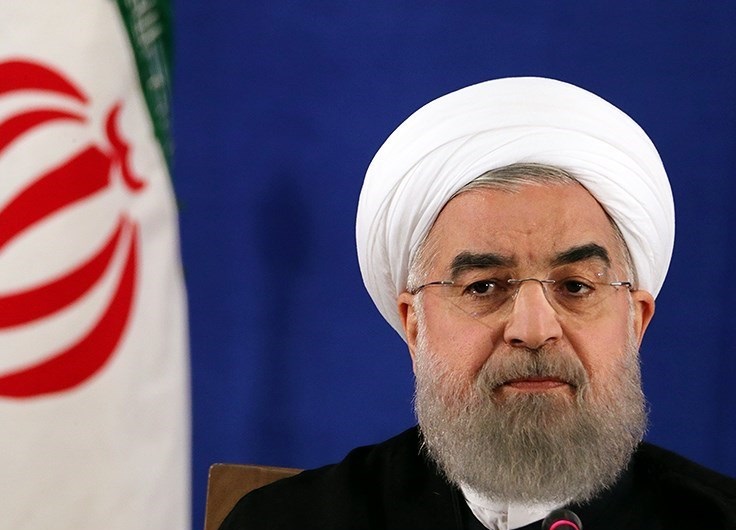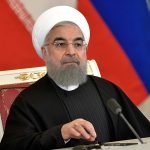By Amir Delshad
Two weeks after the eruption of protests in Iran due to the rise in petrol prices, the unrests may have subsided but discontent is still on the rise, like the clam before the storm which may erupt once more in the not so distant future.
Without prior notice, petrol prices were increased in Iran at midnight on Friday November 15. The price of rationed petrol rose by 50 percent and free petrol by 300 percent. From the afternoon of that very same day, protests began in small towns and the poorer areas of larger cities, reaching a zenith on Saturday.
Based on official reports, 28 out of 31 Iranian provinces and over 100 cities were engulfed by protests. To counter the situation, the government disconnected the internet on a national level to prevent the protesters from using social media. According to the Minister of the Interior, Rahmani-Fazli, over fifty military posts were attacked, 731 banks, 140 public spaces, 70 petrol stations, 307 private cars, and 183 military vehicles were set on fire.
The exact number of people who lost their lives is not clear. Amnesty International has reported 143 deaths during the unrests; but this has been denied by Iran. Even so, Iranian officials have confirmed that the protests were the most widespread and violent the country had experienced in recent years. The spokesperson for the Iranian Parliamentary Committee on National Security and Foreign Policy, Naghavi-Hosseini, placed the number of arrests at over 7,000.
Iranian authorities have announced that bank arsons and unrests were the work of insurgents, counter-revolutionaries, and the enemies of Iran. Iran’s Intelligence Ministry has even reported the arrest of CIA agents involved in the protests. Although the opposition in exile, such as the People’s Mojahedin Organization and supporters of the ousted Pahlavi monarchy, may be attempting to exploit popular protests, the fact that people are not satisfied with the current economic situation cannot be denied.
Reasons for petrol price rises
The Iranian government has cited social justice and help for the lower-income classes, as well as controlling petrol consumption and imports, and environmental issues as the main reasons for the hike in petrol prices. It announced that it will use the resulting income to credit the accounts of 60 million people from Iran’s 84 million strong population on a monthly basis.
However, most economic experts have opposed the plan. They believe the lower-income brackets could have received government help through increased taxes on higher income brackets. Iranian economist, Mahmoud Jamsaz, said that government policies have led to the collapse of the middle classes and there is now a rich minority and a poor majority in Iran.
Famous Iranian sociologist, Emad Afrough, has also said: “From a sociopolitical viewpoint, we no longer have a middle class. We have a ruling class that decides, and a large lower class that has to obey.”
Even those economists who agree with petrol price rises believe that this should have been implemented step by step with a maximum price increase of 20 percent per year. Most experts believe that the plan has been carried out to offset the government deficit given the drop in oil sales, restrictions on other exports, and foreign currency earnings; although, the Iranian government strongly rejects this.
Impacts on domestic policies
The rise in petrol prices has eroded what little social capital Rouhani had left. The hardliners called this an imprudence by the government and began to exploit it to weaken the moderates. Hence, it seems that in the next Iranian parliamentary elections due in March, hardliners and conservatives will be the winners.
The decision-making approach to the price rise has also been criticized by some lawyers and lawmakers, because it was taken by an organ which has no place in the Iranian Constitution and was formed by the Supreme Leader of the Revolution a few weeks after the U.S. withdrawal from the Joint Comprehensive Plan of Action (JCPOA) nuclear deal.
The Supreme Council for Economic Coordination of the three branches headed by the president, parliament speaker, and head of the judiciary approved the plan which was endorsed by the Supreme Leader; whereas, such decisions must be ratified by Parliament. Thus, this shows the discrediting of parliament and a departure from processes and democratic and transparent decision-making.
Impact on nuclear negotiations
The eruption of protests and unrests in Iran must have led the U.S. administration to conclude that maximum pressure is working and its continuation will bring Iran to its knees. Inebriated with the protests, they are further distancing themselves from any negotiations. Be that as it may, it is a mistake to conclude the undisputed surrender of the proud leaders of Iran to the U.S.
After reducing the unrests, the Supreme Leader of Iran pointed out in a speech that “Both friends and foes should know that we have repelled the enemy in the war in military, political and security issues. The recent actions were security issues, not from the people. We have repelled the enemy in various areas, and by God’s grace, we will also definitely repel the enemy in the economic war.”
Regardless of the outcome of this war, what is clear is that the parties are far from diplomacy. Even the EU seems to be moving closer to the U.S. camp.
What will be the future of the protests?
Although the security forces were able to squelch the protests far more violently than previously, dissatisfaction is higher and the impact of petrol prices on other goods may add fuel to the fire and unrests may erupt once again intensely and more widespread.
The government has stressed that the price of other goods will not rise. But economics and existing evidence say otherwise. Urban transportation and, consequently, fruit prices have risen as we speak and it is possible that other goods and services will follow suit.
While protesters in the aftermath of the 2009 elections were predominantly the urban middle classes, the base of recent protesters, as well as the December 2017 protesters, were mostly the lower-income classes and the unemployed youth living on the margins of cities. This is very dangerous for the Iranian establishment, as the latter have nothing to lose and no prospects of improving their lives in terms of employment and welfare.
Yet, lack of leadership among the protesters, the absence of a potential alternative to the current Iranian system, lack of a strategic goal among the protesters, a fear of civil war and total infrastructural collapse among the people, and the use of extreme force and range of methods by the establishment to crush the protests does not currently provide the prospects for regime change.
Amir Delshad is a freelance journalist in Iran.






Maximum pressure of Ayatollah sanctions on Iran is at the root of these problems.
The EU remains committed to JCPOA as evidenced by Belgium, Netherlands, Denmark, Finland, Norway and Sweden recently joining Instex. One barrier to activation of Instex and providing relief to the people of Iran is the need for greater transparency in Iran’s financial system. If money that flows into Iran is corrupted away and not used to benefit the people of Iran it the prospective partners of Iran may feel it would be better to deal with other countries.
Rouhani has claimed he did not know of the timing of the gasoline price increase, that this was a decision of another official. The IRGC blames Rouhani, that he is out of touch with the needs of the people. Given that Rouhani would commit to reforms it is highly likely that more EU states would join Instex and that substantial trade could result thru the mechanism.
At this point it is exceedingly important that the parliament not be dominated by hardliners after the March elections. A question for the Europeans is how they can strengthen the hand of Rouhani to continue to support JCPOA and to initiate reforms that would result in a major increase in trade despite the U.S. sanctions.
Iran’s internal political system is very complex and difficult to understand by many of us, including I, living abroad. Within the recent past the far right members in the House (Majles) have attempted to impeach a few ministers of Rouhani’s administration. So there’s no friendly relationship between some of the House members and the moderate Government.
I can’t believe that Rouhani would lie publicly that he didn’t know of the fuel price hike until it happened. It’s possible that the price hike did happen without his knowledge as a set up from the right wing to win the majority in the House in March of 2020. Nevertheless the Population of Iran was 32-34 million people when I left the country at which time Iran had 5 oil refining facilities. Today the population has increased by almost a factor of 3 and Iranians may have built 1 or 2 additional oil refinery within the past 5 decades. So the simple economic equation of of supply and demand for the fuel is out of control which justifies the price hike due to a very high demands for the fuel. At the same time, tons of fuel were being smuggled out of the country and taken to the neighboring countries because of the lower fuel cost in Iran. That is an additional unaccounted demand for the fuel.
I agree with the author about the method by which the fuel price was increased over night. Instead it should have been increased over a longer period of time so the impact of the price hike on general population could be assessed, reviewed, and adjusted periodically.
The mismanagement of many actions in Iran is due to having a fragmented decision making processes that sometimes the left hand doesn’t know what the right hand is really doing. This process is also a good platform for lack of government transparency even to those who are living there!
In autocracies, one may not find the so called ‘ transparency’. Iran has been passing through turbulence since 1979 revolution.
The maximum pressure unleashed by USA in the aftermath of its withdrawal from JCPOA is clearly visible.Inflation coupled with economic distress, corruption at higher level etc.are some contributing factors.
Another vital factor for distressing economy is Tehran’s involvement in regional, neighborhood conflicts like Syria, Yemen and extending all out support for Hezbollah against Israel etc added disadvantages.
Iran’s economy is not sufficient to cater the needs to its growing population, rehabilitation and development let alone embarking nuclear weapons program.
The fluid political situation in Iraq may add some salt.
If the present state of unrest continues time is not far to witness another revolution of 1979.
Monty Ahwazi
You do not know the Iranian people.
They would have swarmed around the gas stations to grab as much cheap fuel as possible: clogging the roads and preventing even fuel trucks to get through.
The very same people would have stored that cheap fuel at home or their shops, posing a danger to themselves and others, so that they could make a few pennies.
The smugglers would habe real happy with the course of action you suggest, the would alter more vehicle to smuggle fuel to Pakistan and to Afghanistan and too Sheikhdoms.
There are millions of unpatriotic Iranians that do not give a damn about Iran.